Misterios de la gente de las nubes
Una exposición en Lima exhibe las momias de la cultura Chachapoyas, una de las más desconocidas. 500 años para ser admiradas.
Tras pasar por Austria e Italia, Lima acoge la exposición Momias de Leymebamba que abrirá sus puertas el próximo jueves en el Museo de la Nación según informa en su edición digital el diario El Comercio de Perú.
La muestra reúne 93 piezas del Museo de Leymebamba entre las que destacan doce fardos funerarios que se encuentran en un excelente estado de conservación. También se pueden observar varias objetos de cerámica y otros utensilios realizados en madera o en metal que pertenecen a la antigua cultura Chachapoyas, una de las civilizaciones más desconocidas por los investigadores.
"Este patrimonio cultural es casi desconocido para los peruanos, por lo que esperamos que el público aproveche la oportunidad de apreciar su gran valor científico, artístico y cultural", ha afirmado Sonia Guillén, directora del Museo Leymebamba, en una nota informativa. Una vez finalicé la muestra en Lima, todas las piezas regresarán a Leymebamba que cuenta con un museo que ha sido construido con fondos provenientes de Austria e Italia.
Lo más espectacular de la exposición son, sin duda, las momias que durante casi 500 años han permanecido ocultas en un mausoleo situado en la Laguna de los Cóndores, una zona boscosa del noreste de Perú. Las momias fueron descubiertas en noviembre de 1996 por varios agricultores que querían encontrar tesoros aunque el uso de los machetes para cortar los fardos funerarios destruyó la valiosa información de contexto. En 1997 se realizó una misión de recuperación autorizada por el Gobierno peruano y se guardaron más de 200 momias y diversos objetos de ofrenda.
Las momias corresponden a tres épocas de la cultura Chachapoya: Chachapoya (800 - 1470 d. C.), Chachapoya - Inca (1470 - 1532 d. C.) y Colonial Temprano (1532 - 1570 d. C.).
Al parecer, los Chachapoya buscaban sitios inaccesibles para depositar los cuerpos de sus antepasados con unas técnicas de embalsamar que han permitido que las momias hayan llegado hasta nuestros días en un excelente grado de conservación.
Fuente: El País.com, 10 de enero de 2007
Enlace: http://www.elpais.com/articulo/cultura/500/
anos/ser/admiradas/elpepucul/20070110elpepucul_1/Tes
(2) Otro misterio incaico sigue sin poder ser revelado
Doce momias halladas en la selva amazónica peruana serán expuestas en Lima. Asombra a los arqueólogos la "excelente conservación" e intentan dilucidar cómo lograron guardarlas.
Las momias descubiertas en la selva amazónica peruana continúan sorprendiendo a los investigadores que las encontraron siete años atrás, por la manera en que fueron procesadas.
"Aún no sabemos qué utilizaban los incas, eso es lo más asombroso que tenemos en esta exposición, mirar el excelente estado de conservación de las momias, procesadas con hierbas, naturalmente, pero todavía es un misterio el cómo", dijo a AP Sonia Guillén, la arqueóloga a cargo del cuidado de las momias descubiertas en 1996 en la amazonía peruana.
La exposición "Misterios de la gente de las nubes" salió por primera vez de Leymebamba, a 800 kilómetros al noreste de Lima, ciudad en la que se encuentra un museo con 2.049 cuerpos de niños, jóvenes, y ancianos, momificados con procedimientos incas, con una antigüedad de alrededor de 500 años.
Doce momias y 81 objetos, entre vasijas, instrumentos musicales y otros fueron presentados por primera vez en Italia y Austria. Ahora se apresta a ser expuesta por tan sólo un mes en Lima para luego retornar a su lugar de origen.
En la muestra se muestran momias, algunas aún envueltas en los llamados fardos, capas de telas que en ciertos casos llegan hasta seis, que envuelven a los cuerpos colocados con las piernas recogidas, tocando los huesos maxilares, y que presentan un admirable estado de conservación, algunas incluso mantienen aún toda su dentadura.
"Lo que aún nos sorprende, y nos mantiene en misterio es cómo lograron conseguir un proceso de momificación tan perfeccionado", reiteró Guillén, mientras enseñaba los pliegues de piel que aún se sostienen en los cuerpos.
Dijo que estas momificaciones se destacan porque fueron conseguidas en un medio ambiente hostil para este proceso, con humedad, insectos, y altas temperaturas.
La científica lamentó que muchos de los objetos arqueológicos de esta cultura Chachapoya (por el lugar donde habitaban)-inca hayan sido saqueados. "Algunas momias tienen huellas del maltrato de cuchillos, machetes, y otros objetos que utilizó la gente para extraer y vender los tesoros".
Dijo que los investigadores están "en una carrera" para sacar todo lo que se encuentre de esta cultura y ponerlo en resguardo para evitar la explotación ilegal.
Sin embargo, indicó que lo recuperado ha sido suficiente para mantener los constantes estudios científicos de los cuerpos y que ha ayudado a los investigadores a develar la vida de esta cultura, reconocida por su arqueología, y que se dedicaba a la agricultura y la guerra.
"Hemos encontrado momias que demuestran que este pueblo sufría de tuberculosis, y otras que registran el pasado guerrero de esta gente", indicó Guillén, y señaló que entre los cuerpos encontrados se hallaban hechiceros (chamanes), jefes incas, y otras personalidades del pueblo que habitó en la selva.
Fuente: AP, 10 de enero de 2007
Enlace: http://www.infobae.com/notas/nota.
php?Idx=295668&IdxSeccion=600795
(3) Moment 600 years ago that terror came to Mummies of the Amazon
by BARRY WIGMORE
Hands over her eyes and her face gripped with terror, the womans fear of death is all too obvious.
The remarkable mummy was found in a hidden burial vault in the Amazon.
It is at least 600 years old and has survived thanks to the embalming skills of her tribe, the Chachapoyas or cloud warriors.
Eleven further mummies were recovered from the massive cave complex 82ft down.
The vault - which was also used for worship - was chanced upon three months ago by a farmer working at the edge of northern Perus rainforest. He tipped off scientists who uncovered ceramics, textiles and wall paintings.
The Chachapoyas were a tall, fairhaired, light-skinned race that some researchers believe may have come from Europe.
Little is known about them except that they were one of the more advanced ancient civilisations in the area. Adept at fighting, they commanded a large kingdom from the year 800 to 1500 that stretched across the Andes.
It is not known what the Chachapoyas actually called themselves - they are identified by the name given to them by their rivals and eventual conquerors, the Incas.
It comes from the Incas Quechua language and means cloud people, because of the high forests in the clouds that the Chachapoyas inhabited.
Virtually all record of the tribe was lost when the Incas were themselves overrun by the Spanish conquistadors who landed in 1512.
They have, however, left behind a spectacular citadel, called Kuelap, 10,000ft up in the Andes.
It has more than 400 buildings and defensive towers, many of them with decorated walls, cornices and friezes.
Some experts rate Kuelap more highly than the Incan ruins at Machu Picchu.
Herman Crobera, the leader of the archaeological team that explored the cave, said: This is a discovery of transcendental importance.
It is the first time any kind of underground burial site this size has been found belonging to Chachapoyas or other cultures in the region.
He said walls near the mummies in the limestone cave were covered with paintings of faces and warriorlike figures which may have been drawn to ward off intruders and evil spirits.
The remote site for this cemetery tells us that the Chachapoyas had enormous respect for their ancestors because they hid them away for protection, added Mr Crobera.
Locals call the cave Iyacyecuj, or enchanted water, because of its spiritual importance and its underground rivers. The archaeologists have not yet established an accurate age for their finds.
Once they have finished exploring and excavating the tomb, Peruvian authorities want to turn it into a museum. The mummies are going on show at the Museum of the Nation in the capital Lima.
Source Link: http://www.dailymail.co.uk/pages/live/articles/
news/news.html?in_article_id=427999&in_page_id=1766&ito=1490
Galería Fotográfica:
A mummy from the Chachapoyas culture is displayed in the Museum of The Nation before an exhibition in Lima, January 9, 2007. The Museum of The Nation will open an exhibition on January 11, 2007, showing around 12 mummies found in the Amazon rainforest region of Chachapoyas, northern Peru, dating from between 900 and 1500 from the Chachapoyas and the Incas cultures. REUTERS/Mariana Bazo (PERU)
The bundle of a mummy from the Chachapoyas culture is displayed in the Museum of The Nation before an exhibition in Lima, January 9, 2007. The Museum of The Nation will open an exhibition on January 11, 2007, showing around 12 mummies found in the Amazon rainforest region of Chachapoyas, northern Peru, dating from between 900 and 1500 from the Chachapoyas and the Incas cultures. REUTERS/Mariana Bazo (PERU)
A security guard stands next to a mummy from the Chachapoyas culture that is displayed in the Museum of The Nation before an exhibition in Lima, January 9, 2007. The Museum of The Nation will open an exhibition on January 11, 2007, showing around 12 mummies found in the Amazon rainforest region of Chachapoyas, northern Peru, dating from between 900 and 1500 from the Chachapoyas and the Incas cultures. REUTERS/Mariana Bazo (PERU)
A mummy of a baby from the Chachapoyas culture is displayed in the Museum of The Nation before an exhibition in Lima, January 9, 2007. The Museum of The Nation will open an exhibition on January 11, 2007, showing around 12 mummies found in the Amazon rainforest region of Chachapoyas, northern Peru, dating from between 900 and 1500 from the Chachapoyas and the Incas cultures. REUTERS/Mariana Bazo (PERU)
A worker of the Museum of The Nation moves a mummy while preparing an exhibition of the Chachapoyas culture in Lima, January 9, 2007. The Museum of The Nation will open an exhibition on January 11, 2007, showing around 12 mummies found in the Amazon rainforest region of Chachapoyas, northern Peru, dating from between 900 and 1500 from the Chachapoyas and the Incas cultures. REUTERS/Mariana Bazo (PERU)
A mummy from the Chachapoyas culture is displayed in the Museum of The Nation before an exhibition in Lima, January 9, 2007. The Museum of The Nation will open an exhibition on January 11, 2007, showing mummies found in the Amazon rainforest region of Chachapoyas, northern Peru, dating from between 900 and 1500 from the Chachapoyas and the Incas cultures. REUTERS/Mariana Bazo (PERU)
Archeologists prepare a mummified body for an exhibition at the National Museum in Lima, Tuesday, Jan. 9, 2007. The exhibition called Mysteries of the People of Clouds will display 20 mummies with an antiquity of around 500 years.(AP Photo/Martin Mejia) Email Photo Print Photo
An archeologist prepares a mummified child for an exhibition at the National Museum in Lima, Tuesday, Jan. 9, 2007. The exhibition called Mysteries of the People of Clouds will display 20 mummies with an antiquity of around 500 years.(AP Photo/Martin Mejia)
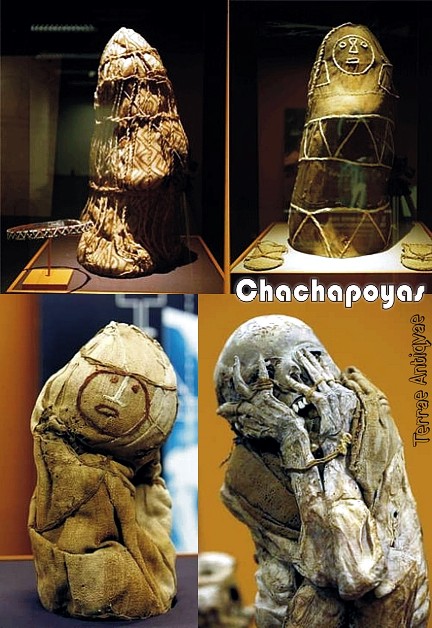
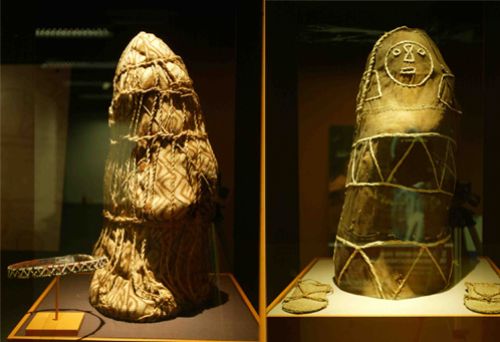
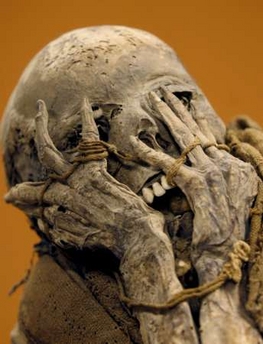
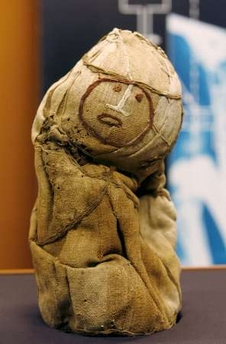
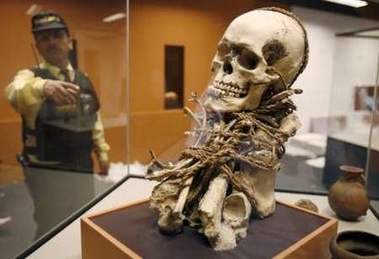
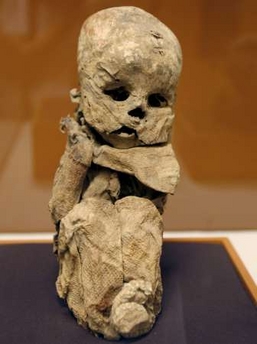
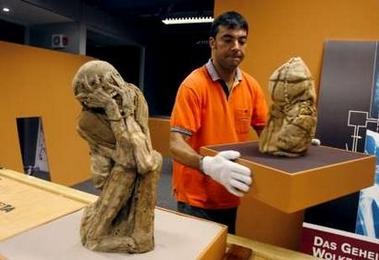
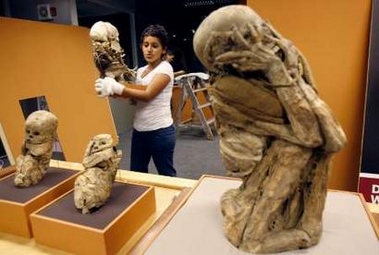
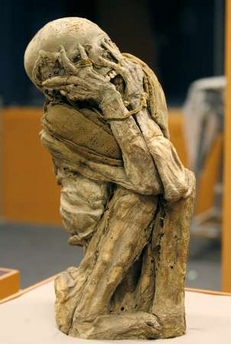
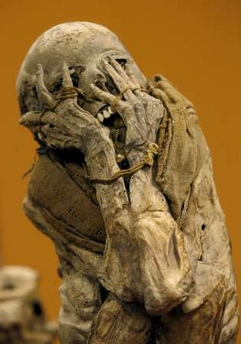
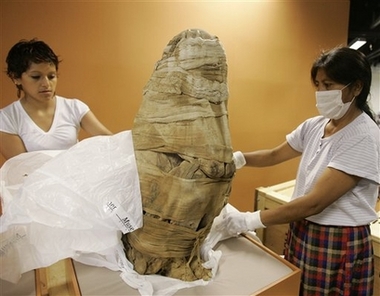
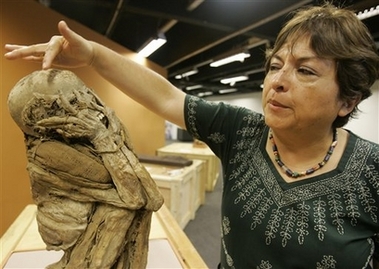
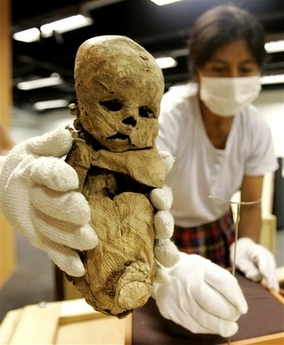
2 comentarios
juan miguel -
Enhorabuena por la web. Es genial.
E.Castilho -
Na foto em que uma senhora quase a toca, o crânio parece pequeno em comparação ao da senhora - seria uma adolescente? (Um dos textos acima diz que eles eram altos).
Creio que os arqueologistas também se fizeram estas perguntas e já têm as respostas. Poderia eu as ter aqui na Revista?